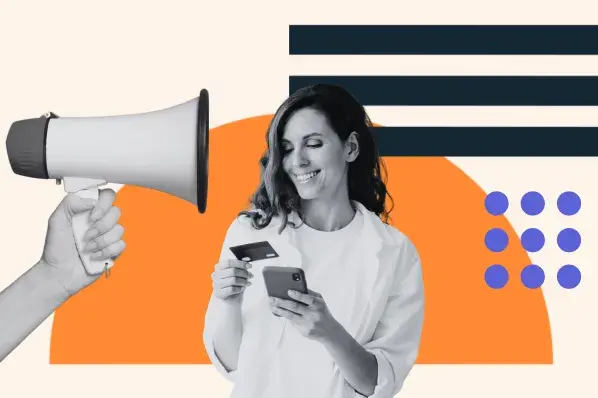I ran a GlimpseAhead survey of 100 service, support, and customer experience professionals about the biggest customer acquisition challenges they’ve had and what they think businesses should be on the lookout for the most.
In this post, I’ll walk you through their responses and share what you should keep in mind for the year ahead.
Customer Acquisition Challenges You May Face This Year
- Adapting to Meet Current Customer Needs
- Crafting Effective Messages for Communicating With Customers
- Choosing and Leveraging the Right Tools and Technologies
- Prioritizing Customer Acquisition Over Customer Retention
- Addressing the High Cost of Marketing and Sales Misalignment
- Noting Changes in Customer Preferences That Impact Your Customer Acquisition Tactics
- Investing in New Automation Technology or AI to Streamline Customer Acquisition Strategies
I wanted to first understand how different professionals felt about the customer acquisition roadblocks and challenges they dealt with in the past. Below is the summary of the survey, which looks at both the problems presented and the solutions.

1. Adapting to Meet Current Customer Needs
Problem: Tailoring your messaging to cater to specific customer needs and preferences requires a strong sense of business acumen and appetite to understand customer needs. I believe adopting a customer-centric approach, backed by data, is crucial to effectively understanding these challenges.
Solution: Identify your customer’s business goal, and conduct in-depth discovery to comprehend the use-cases a customer has with your products and services to increase their engagement with your company.
2. Crafting Effective Messages for Communicating With Customers
Problem: Crafting effective customer messaging and communication is critical to my customer acquisition strategy. This messaging forms the bridge between my business and potential customers. I often face challenges such as not having accurate or detailed data on my target demographic, misidentifying customer needs or pain points, and inconsistencies in tone and branding. Additionally, prospects are constantly influenced by ever-changing market trends, making it difficult to keep my messaging relevant. Without clear, enticing messaging, it becomes challenging to capture and maintain attention.
Solution: Have your go-to-market teams collect and update the same data about their customers consistently. Giving your marketing, sales, and service teams access to this same data means that you can rely on up-to-date information about your customers, and better target them for continued engagement.
3. Choosing and Leveraging the Right Tools and Technologies
Problem: Service professionals face challenges in getting the right tools for their customer acquisition strategy due to the abundance of choice, varying technical capabilities, budget limitations, integration complexities, and needing to stay abreast of evolving digital trends. After all, it seems like there are new AI tools coming out every other day.
Selecting, implementing, and optimizing tools that align with business goals and cater to customer needs requires extensive research to drive successful acquisition effectively. Moreover, the tech may be too new to know whether it is effective or not.
Solution: I advise customers to identify and prioritize tools that accelerate their customers’ experience through: focusing on the experience first, collecting customer behavior data consistently, and having a flexible infrastructure to link to other systems. These and other principles can help your company leverage your tools to work for you rather than you being burdened by them.

4. Prioritizing Customer Acquisition Over Customer Retention
Problem: Focusing too much on customer acquisition at the expense of retention can be costly and inefficient. Studies show that it is 5 to 25 times more expensive to acquire new customers than to retain existing ones.
When businesses prioritize acquisition, they often overlook the value of their existing customers, who can be your brand ambassadors, drive more revenue through repeat purchases, and generate referrals. If you fail to retain customers, this can create a leaky bucket effect: new customers just replace lost ones, thereby limiting long-term growth potential.
Solution: To prevent over-prioritizing acquisition, I focus on retaining existing customers first and prioritizing their satisfaction. By ensuring customers fully understand how to use products or services to achieve their goals, businesses can cultivate long-term value. Moreover, establishing a customer success team to proactively help users maximize their product’s value can encourage repeat business — and position you as a trusted partner. Satisfied customers are more likely to refer others to your business, contributing to organic growth and lower acquisition costs.
5. Addressing the High Cost of Marketing and Sales Misalignment
Problem: Go-to-market professionals need to ensure that their marketing and sales teams are united in their approach to acquire new customers. Misaligned marketing and sales teams – unorganized messaging, inconsistent handoffs, and little commitment for a feedback loop – can amplify the customer acquisition challenges you already have.

Solution: I recommend aligning your sales and marketing teams, starting with a shared understanding of your buyer personas. Both teams need to operate from this shared understanding of the target audience’s needs, pain points, and motivations.
This alignment can initiate consistent communication throughout the customer journey, foster smoother handoffs between marketing and sales, and encourage a feedback loop that refines strategies over time. Regular collaboration, joint meetings, and shared metrics can further solidify this alignment, driving a more cohesive approach to acquiring new customers.
6. Noting Changes in Customer Preferences That Impact Your Customer Acquisition Tactics
Problem: Customer preferences are constantly evolving, and businesses must adapt to these changes to optimize their customer acquisition strategies. The challenge lies not only in recognizing shifts but also in translating them into actionable tactics. Companies must navigate customer demands for greater value, rising expectations for service quality, personalized interactions, and innovative technology solutions. Failure to address these expectations can significantly hinder acquisition efforts and erode trust in the brand.
Solution: I recommend delivering more value for less – customers are increasingly seeking more value in the most efficient manner, comparing the perceived benefits of products or services against their price.
Businesses should focus on highlighting the quality, features, and uniqueness of their offerings, emphasizing how to deliver greater value than their competitors. This involves meeting rising customer service expectations – demonstrating transparency and responsiveness.
Communicating clearly and committing to addressing customer needs can enhance trust and encourage more word-of-mouth referrals. In my experience, providing exceptional service is now a requirement to stay competitive. This can be accentuated by providing personalized experiences that mirror the messaging. HubSpot’s Annual State of Service Report notes that “78% of customers expect more personalization in interactions than ever before.” Aligning marketing and sales teams, sharing data, and targeting segments more effectively can build deeper connections.

7. Investing in New Automation Technology or AI to Streamline Customer Acquisition Strategies
Problem: 50% of service professionals claim they will or already have plans to invest in new automation technology like AI to streamline customer acquisition in 2024. However, 25% of the respondents stated they would not invest in AI due to the risk and/or difficulty of getting leadership buy-in.
Using AI feels risky, considering recent headlines of certain companies landing in hot water for copyright infringement and other lawsuits. Additionally, service professionals see the value of automation technologies but often can't convince decision-makers.
Solution: Overcoming these challenges is tricky. To convince leadership about investing in new technologies such as AI, I would focus on framing these solutions as a strategic enabler. When I presented these solutions, I highlighted the benefits and used case studies where AI-driven processes successfully improved customer satisfaction. Realizing the benefits of these solutions through small pilot projects can also help convince others by demonstrating initial progress with a pilot group.
Gradually integrating automation can enable companies to build confidence in leadership while showing quantifiable improvements. Regular communication about AI’s benefits — coupled with ongoing feedback — will help align decision-makers to invest in technologies that streamline acquisition processes.
Metrics for Measuring Customer Acquisition Strategy
There are numerous metrics customer service teams use to inform the overall experience they have with customers. To get a pulse check on the metrics service professionals are currently using to measure their strategies and gauge success, I closed with this last prompt.
What metrics do you use to measure your customer acquisition strategy in 2024?
The three metrics outlined below are key to providing insights into addressing your customer acquisition challenges.

Customer Retention Rate (43%)
Service professionals primarily keep an eye on customer retention rate (CRR). As a customer success leader, this metric quantifies customer loyalty and informs your acquisition efforts.
A high CRR leads to lower acquisition costs and increased customer lifetime value as you focus on increasing the investment with your current customers. Conversely, a low CRR signals retention challenges that need attention to sustain growth and profitability. Monitoring CRR helps service professionals make informed decisions and prioritize efforts for effective strategies, removing customer acquisition roadblocks.
Customer Lifetime Value (21%)
Customer lifetime value (CLV) is crucial for addressing your customer acquisition challenges, as it provides insights into the long-term profitability of acquiring, retaining, and growing customers.
A healthy CLV is difficult to achieve and maintain – it requires accurate data, predictive analytics, an elevated level of customer relationship management, and a deep understanding of customer behaviors and preferences.
Service professionals must invest in building strong customer relationships, delivering exceptional experiences, and continuously optimizing strategies to maximize CLV. This can be challenging amid changing markets, evolving customer expectations, and fierce competition.
Despite the difficulties, a solid CLV metric can act as a symbol of your formidable brand value to effectively address your customer acquisition challenges by prioritizing high-value customers.
Customer Acquisition Cost (21%)
Tied with CLV, the expenses incurred to acquire customers – customer acquisition cost (CAC) – determine the effectiveness of your acquisition strategies in relation to the revenue generated from new customers.
A healthy CAC is challenging to achieve as it involves balancing the costs of acquiring customers with the value they bring to the business. Furthermore, maintaining it is harder when marketing is becoming increasingly expensive to generate more customers.
However, maintaining a low CAC means that you are effectively controlling your customer acquisition roadblocks and tracking with your customer’s needs as they relate to your products and services.
How to Stay Ahead of Customer Acquisition Challenges
To achieve profitability in 2024 and beyond, addressing customer acquisition challenges is crucial. Throughout my career, I have found that overcoming these obstacles requires understanding them, adapting strategies accordingly, and tracking progress with measurable outcomes. By confronting these issues directly and using data to guide decisions, you can create a foundation for long-term success and sustainable growth in your service business.
Editor's note: This post was originally published in October 2024 and has been updated for comprehensiveness.
.png?width=112&height=112&name=Image%20Hackathon%20%E2%80%93%20Vertical%20(67).png)
.webp)
.png)

-2.png)







